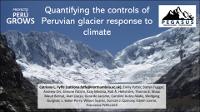Quantifying the controls of Peruvian glacier response to climate
Autor(es)
Fecha
2021-04Colecciones
- Congreso [33]
Recurso(s) relacionado(s)
https://meetingorganizer.copernicus.org/EGU21/EGU21-7524.htmlResumen
Peruvian glaciers are important contributors to dry season runoff for agriculture and hydropower, but they are at risk of disappearing due to climate warming. Their energy balance and ablation characteristics have previously been studied only for individual glaciers, with no comparisons between regions. We applied the physically-based, energy balance melt component of the model Tethys-Chloris at five on-glacier meteorological stations: three in the Cordillera Blanca near Huaraz (with glaciers above ~4300 m a.s.l.), and two in the Cordillera Vilcanota east of Cusco (with glaciers above ~ 4800 m). The climate of these regions is strongly seasonal, with an austral summer wet season and winter dry season. Our results revealed that at most sites the energy available for melt is greatest in the wet season. This is a consequence of the dry season energy losses from the latent heat flux and net longwave radiation which counter-balance the high dry season net shortwave radiation, which otherwise dominates the energy balance. The sensible heat flux is a relatively small contributor to melt energy in both seasons. Comparison of the five sites suggests that there is more energy available for melt at a given elevation in the Cordillera Vilcanota compared to the Cordillera Blanca. At three of the sites the wet season snowpack was discontinuous, forming and melting within a daily to weekly timescale. Albedo and melt are thus highly variable in the wet season and closely related to the precipitation dynamics. At the highest site, in the accumulation zone of the Quelccaya Ice Cap, 81% of ablation was from sublimation. Sublimation was less important at the lower sites, but it reduces dry season melt. Correlation of the NOAA Oceanic El Niño Index (ONI) to the outputs of the two sites with the longest records revealed that the warmer wet season temperatures characteristic of a positive ONI were associated with a decreased albedo, greater net shortwave radiation, a more positive sensible heat flux and increased melt rates. Air temperature and precipitation inputs were also perturbed at all five sites to understand their sensitivity to climate change. Enhanced mass loss was predicted with a static increase of 2°C or more, even with a +30% precipitation increase, with the lower elevation Cordillera Blanca sites at risk of the greatest mass loss due to warming.
El ítem tiene asociados los siguientes ficheros de licencia:








